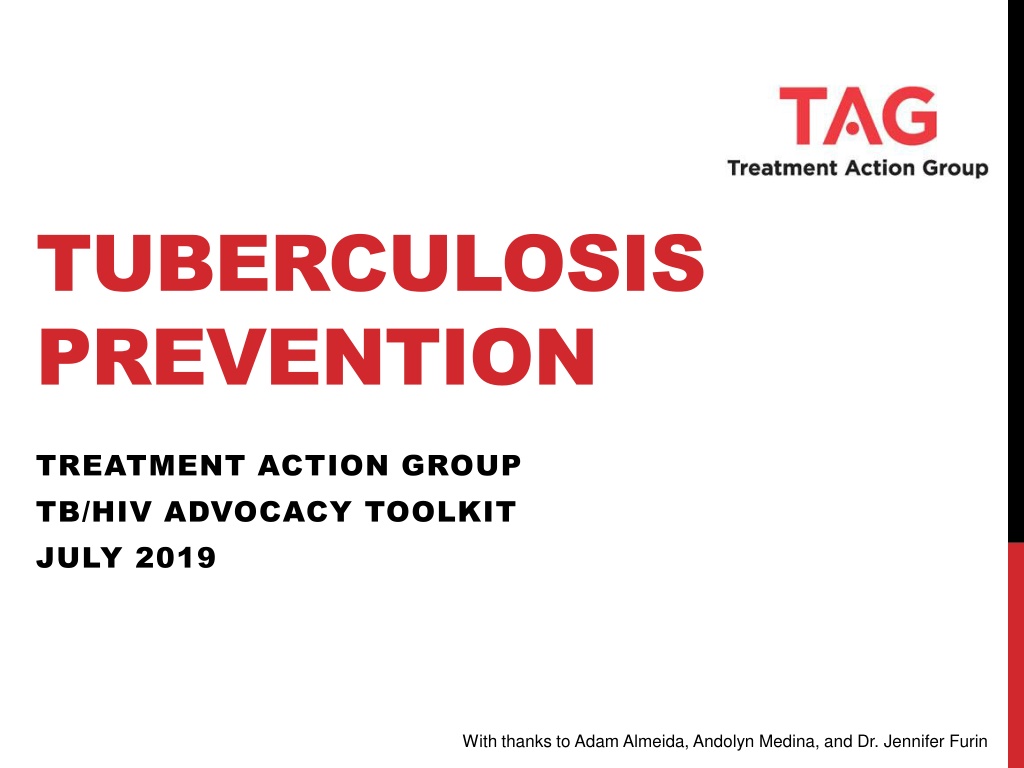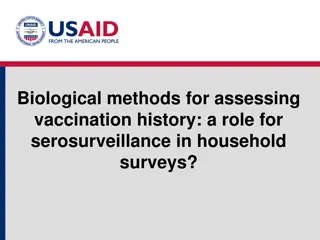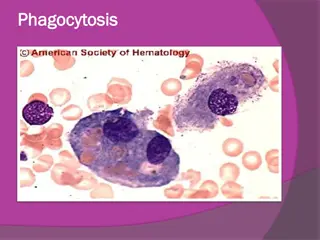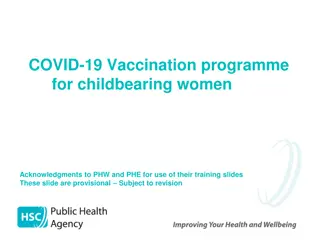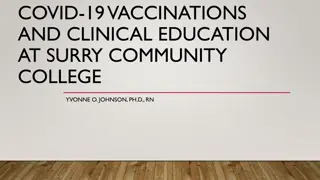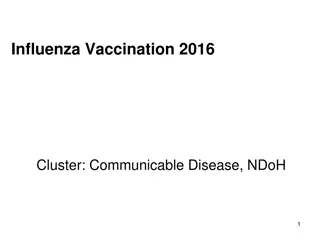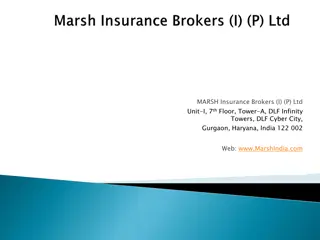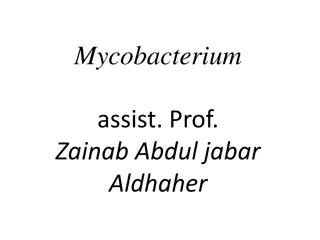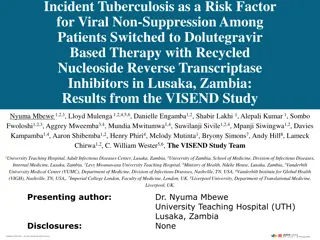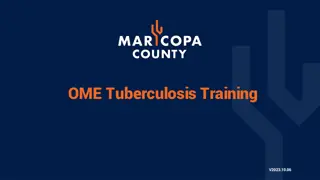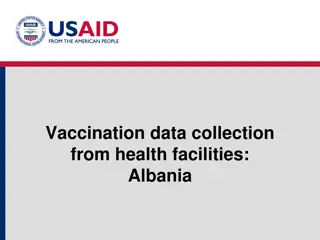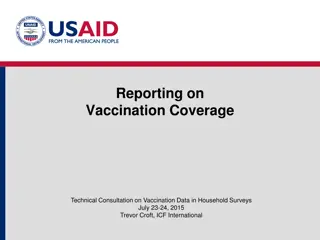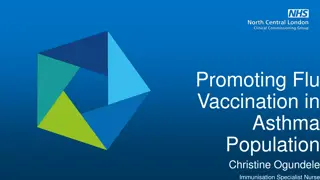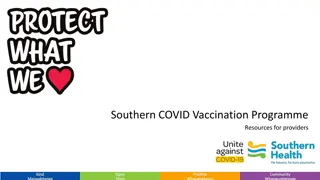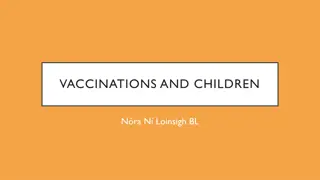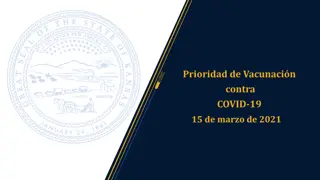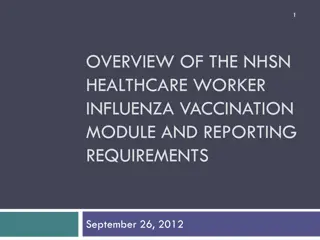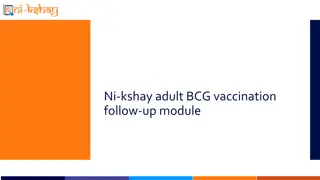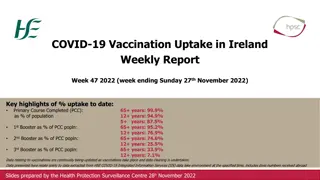Understanding Tuberculosis Prevention and Vaccination
Learn about the fundamentals of tuberculosis prevention, the types of vaccines available, and current vaccines like Bacille Calmette-Guérin (BCG). Discover the limitations of the BCG vaccine and target populations for vaccination to combat tuberculosis effectively.
Download Presentation

Please find below an Image/Link to download the presentation.
The content on the website is provided AS IS for your information and personal use only. It may not be sold, licensed, or shared on other websites without obtaining consent from the author. Download presentation by click this link. If you encounter any issues during the download, it is possible that the publisher has removed the file from their server.
E N D
Presentation Transcript
TUBERCULOSIS PREVENTION TREATMENT ACTION GROUP TB/HIV ADVOCACY TOOLKIT JULY 2019 With thanks to Adam Almeida, Andolyn Medina, and Dr. Jennifer Furin
TOPICS TO BE COVERED Vaccination Fundamentals Current Vaccine Vaccine Research Preventive Therapy Other aspects of TB prevention The Main Points
VACCINATION FUNDAMENTALS
VOCABULARY Primary Prevention: to block infection Secondary Prevention: to stop infection from progressing to disease Immunity: the ability to resist the onset or progression of a disease Vaccine: a substance that is introduced into the body to create immunity against infection or prevent disease progression FUNDAMENTALS FUNDAMENTALS
TYPES OF VACCINES Live, attenuated vaccine: contains germs that are alive and have been weakened so they have lowered disease- causing ability Inactivated vaccine: contains germs that have been killed Toxoid vaccine: contains toxins produced by germs Component vaccine: contains part of germ FUNDAMENTALS FUNDAMENTALS
CURRENT VACCINE FOR TB
CURRENT VACCINE Bacille Calmette-Gu rin (BCG) is currently the only approved TB vaccine BCG is the world s most widely administered vaccine The WHO estimates that it saves the lives of over 40,000 children each year BCG is a live, attenuated strain of M. bovis It protects infants and young children against severe forms of TB, including: Miliary TB: throughout the body Meningeal TB: in the lining of the brain VACCINE VACCINE
LIMITATIONS OF BCG VACCINE BCG offers limited protection against TB in adolescents and adults The durability of its protection (how long its protective effects last) decreases in early adolescence Whether repeated BCG vaccination can boost protection at different time points over the life course is currently being studied It should not be given to people (including infants) with HIV Because HIV suppresses or weakens the immune system, the live, attenuated vaccine can cause TB disease in these people Target stages/populations for vaccination and where BCG vaccine fits Target stage Infants Adolescents Target population Adults People with HIV (all ages) Active disease Latent infection Pre-infection VACCINE VACCINE BCG
VACCINE DEVELOPMENT PIPELINE Costs associated with the development of a portfolio of TB vaccine candidates Field Site Preparation ($2-4 million per year, per site) Manufacturing ($310 million to build and upgrade facilities; $10 million per year) Phase IIb (1 trial per candidate) Phase III (1 trial per candidate) Vaccine Discovery Preclinical Testing Phase I (4 trials per candidate) Phase II (3 trials per candidate) Licensure 8 10 years 4 years 1 - 2 years Costs related to the development of one TB vaccine candidate up to $3.5 million $3 million $18 million $24 million $265 million Direct costs to develop one TB vaccine candidate for one target population could be as much as $315 million Phase III licensure trials are complex and costly Infant trial between $70 and $140 million Adolescent and adult trial between $130 and $265 million Courtesy of Aeras Global TB Vaccine Foundation RESEARCH RESEARCH
VACCINE PIPELINE Current TB vaccine candidates fall into three categories: Priming vaccine: induces an initial immune response Boosting vaccine: strengthens the induced immune response, may be given months or years after the primer Immunotherapeutic vaccine: strengthens the immune response after infection RESEARCH RESEARCH Courtesy of STBP New TB Vaccines Working Group
VACCINE FUNDING, 2017 Source: www.treatmentactiongroup.org/TBRD2018 RESEARCH RESEARCH
CHALLENGES OF TB VACCINE RESEARCH Lack of understanding of BCG Limited understanding of how TB infection and disease occur in the body Difficulty in assessing immunity Limited research capacity Few options for HIV-exposed infants Not enough resources Poor animal models RESEARCH RESEARCH
PROMISING VACCINE CANDIDATES Re-vaccination with BCG may offer some additional immunity. The benefits of this are that the vaccine is widely available, its safety profile in all ages has been assessed, and its cost is reasonable. The protection, however, does not appear to be complete.
PROMISING VACCINE CANDIDATES The M72/ASO1E vaccine provided 54% protection from the development of TB when tested in a phase IIB trial in HIV- negative individuals in Kenya, South Africa, and Zambia who were living with TB infection. The vaccine appeared safe and will be tested in phase III trials if funding is available.
PREVENTIVE THERAPY
PREVENTIVE THERAPY Especially in the absence of a broadly effective vaccine, preventive therapy is extremely important in TB prevention Much like PrEP/PEP in HIV Currently, WHO recommends preventive therapy in all: Childhood household contacts (under 5 years) of someone diagnosed with active TB disease People with HIV as long as active TB disease has been ruled out The most common form of preventive therapy is Isoniazid Preventive Therapy (IPT) Uptake of preventive therapy is too low Only 7% of those who should receive preventive therapy do PREVENTION PREVENTION
TREATMENT REGIMENS FOR LTBI The WHO recommends one of the following treatment regimens for latent TB infection based on drug sensitivity, drug availability, and TB incidence and prevalence: 6-month isoniazid (daily)* 9-month isoniazid (daily)* 3-month rifapentine + isoniazid (weekly) 1-month of rifapentine+ isoniazid (daily) 3-4 months isoniazid + rifampicin (daily) 4 months rifampicin (daily), recommended for people who cannot tolerate or whose TB is resistant to isoniazid Note: none of these regimens would work on drug-resistant strains. Research is underway to see if levofloxacin or delamanid are good options for contacts of people with MDR-TB *the ideal length of IPT is unknown; IPT also comes in a co-formulation with cotrimoxazole to prevent other bacterial conditions PREVENTION PREVENTION Source: WHO Guidelines on the management of latent tuberculosis infection, 2015 http://www.who.int/tb/publications/ltbi_document_page/en/
OTHER ASPECTS OF TB PREVENTION
HOW ELSE TO PREVENT TB? Finding and treating active disease quickly and with the right drugs This is the best way to prevent TB On the right treatment, TB very quickly (<2 weeks) becomes non-infectious This includes active case finding and contact tracing (finding and testing close contacts of known TB cases and other people at high risk) Environmental protections Sunlight or other UltraViolet (UV) light Good ventilation (airflow) fans, open windows In hospitals, negative pressure rooms (if resources allow) In clinics, separating people with cough PREVENTION PREVENTION
HOW ELSE TO PREVENT TB? Other personal, health, and social protections For TB-negative people, wearing an N-95 respirator (N-95 mask) For persons with TB, wearing a surgical mask when coughing may reduce the spread of TB in the first weeks of treatment, but this should not be a requirement and could increase stigma. Improved living conditions (avoid overcrowding) Improved air quality: pollution- and smoke-free Healthy nutrition (both malnutrition and diabetes predispose people to develop active TB) Early initiation of antiretroviral therapy in people with HIV PREVENTION PREVENTION N-95 respirator
INTERVENTIONS FROM INFECTION THROUGH TRANSMISSION Primary prevention vaccine Preventive therapy Improved air quality Reduce overcrowding Infection Exposure Early initiation of antiretroviral therapy UV light Secondary prevention vaccine Mask Transmission Disease Preventive therapy Nutrition Early diagnosis and good treatment of TB Therapeutic vaccine PREVENTION PREVENTION
There are many ways to prevent TBnone perfect so we need to use them all BCG vaccine protects children against the worst forms of TB Preventive therapy is very important for contacts of people with TB Early detection and treatment of TB and HIV is the best way to prevent TB transmission Personal and environmental controls also help prevent TB transmission More research into TB vaccines, basic science, and best strategies for preventive therapy is needed MAIN POINTS MAIN POINTS
ADDITIONAL RESOURCES Treatment Action Group (TAG) has developed An Activist s Guide to Rifapentine for the Treatment of TB Infection: treatmentactiongroup.org/content/activists-guide- rifapentine-treatment-tb-infection
